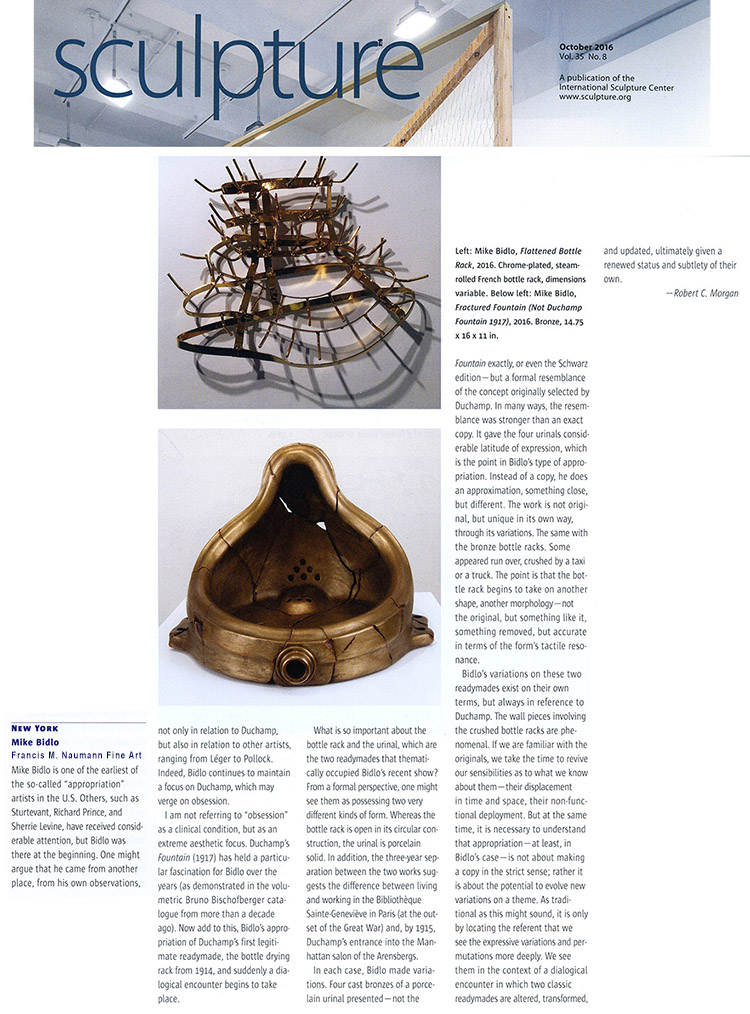![[Francis Naumann]](/4logo.gif)
![[Francis Naumann]](/4logo.gif)

MIKE BIDLO: NOT Duchamp: Fountain and Bottle Rack is the artist’s second solo exhibition at Francis M. Naumann Fine Art (the first—Erased de Kooning Drawings—was held over ten years ago, in 2005).
Bidlo is an appropriation artist, that is to say, he intentionally replicates the work of other artists (sometime introducing variations, sometimes not). In all cases, the work he creates is considered an integral part of his own artistic production, and under no circumstances (especially commercial) does he wish for it be confused with the source work from which it is appropriated. It is for this reason that he usually signs work with his handprint, and titles it as NOT the work of the artist whose work is being appropriated: NOT Brancusi, NOT Picasso, NOT Léger, or, in the case of the present exhibition, NOT Duchamp.
Bidlo here appropriates two readymades by Marcel Duchamp, his Bottle Rack from 1914, and his notorious Fountain of 1917. In both instances, however, the resultant work is radically transformed from its original incarnation: in the case of his Bottle Rack, vintage French bottle racks are “mirrored” in a bright reflective gold/bronze metallic paint, and several were intentionally crushed by a steam roller and subsequently chromed. The Fountain is a porcelain urinal that Bidlo hand-crafted, smashed, reassembled, and then cast into solid bronze (each produced in an edition of eight signed and numbered examples, the same number—not coincidentally—in which Duchamp issued replicas of his readymades in 1964).
The broken urinal echoes an accident that occurred to Duchamp’s Large Glass in the late 1920s (shattered in transit, Duchamp painstaking reassembled it), but also reflects an incident that allegedly occurred in 1917, when, under the pseudonym of R. Mutt, Duchamp submitted the urinal to the first exhibition of the Society of Independent Artists in New York. William Glackens, the society’s president, was in a quandary over whether or not to display of such an indecent object in a public setting, and was said to have solved the problem by raising the piece of plumbing over his head and letting it go, smashing it to pieces and thereby resolving the argument.

About the Artist and his Appropriation of Work by Marcel Duchamp:
Recently, Mike Bidlo has been described as a performance artist who creates “social sculpture” (see: https://en.wikipedia.org/wiki/Mike_Bidlo). This designation was likely inspired by the fact that whenever Bidlo appropriates the work of a given artist, he researches his or her art and life in depth, mirroring much the same approach employed by method-actors in preparing for a biographical role. Bidlo’s first work of appropriation art occurred in 1982 with his Jack the Dripper at Peg’s Place, an installation at PS 1 in Long Island City, where Bidlo recreated a semblance of Peggy Guggenheim’s New York apartment. The walls were covered with photographs of her and the various men in her life, including Jackson Pollock (dubbed “Jack the Dripper” by the press), who was represented in the tableau by a life-sized mannequin urinating into a fireplace (which he was reported to have done on one occasion). Bidlo spent the next two years creating his own version of Pollock drip paintings, replicating the technique practiced by the artist himself of standing over unstretched canvas and spewing pigment onto its surface from a heavily loaded brush.
Over the course of the next three decades, Bidlo has gone on to replicate work by some of the best known artists of the 20th Century: from Paul Cézanne and Giorgio de Chirico, to Roy Lichtenstein and Andy Warhol. Most notably, he spent three years recreating the works of Pablo Picasso, culminating in a highly acclaimed show at the Leo Castelli Gallery in 1988 called “Picasso’s Women.” Although he continued to replicate works by Duchamp in this same period, he only engaged the work in a sustained fashion when, in 1996, he opened a storefront on 5th Street in the East Village called “Saint Duchamp.” There he gathered all his prior Duchamp appropriations for display (two version of the Bicycle Wheel, 1984 and 1986, the Door 11 rue Larrey, 1985, three Bottle Racks, 1985, 1987, 1989, and two examples of Fountain, 1986, 1989), and began recreating other works by the artist (The Nude Descending a Staircase, Tu m’, etc.). It was at this time that Bidlo began the most dedicated and sustained appropriation of a single work in his career, filling an entire studio space with hundreds of drawings of Duchamp’s Fountain. For Bidlo, the very act of being so intensely engaged with a single shape for such a sustained period proved cathartic, a sort of visual purgative that has allowed him to consider variations within the appropriative process, as is demonstrated in the current exhibition.
